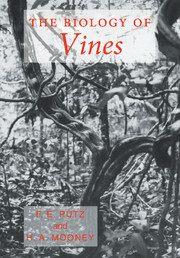Foreword
Published online by Cambridge University Press: 05 November 2011
Summary
Climbing plants – vines – are one of the most interesting, but also a very neglected group of plants. In the rainforests of the tropics, where they reach their greatest abundance and diversity, they climb into the crowns of tall trees, hang down in gigantic loops and often bind one tree firmly to several others. Their stems reach prodigious lengths and are often thicker than a man's thigh. Botanists have long been familiar with their curious stem anatomy and their varied means of attaching themselves to other plants. They are also of considerable economic importance, both as the most troublesome weeds with which the tropical forester has to contend and as sources of valuable drugs such as curare and strychnine. Though more numerous in the tropics, they are also common in temperate regions: in Britain ivy and traveller's joy are conspicuous features of the landscape as Virginia creepers are in North America.
In spite of their varied interest and importance to man, vines have attracted relatively little scientific attention. In the nineteenth century Charles Darwin was fascinated by their structure and behaviour, which he described in his Movement and habits of climbing plants (1875). Later Schenck in Germany wrote two classical memoirs dealing mainly with the stem anatomy of climbers (1892–3). Since then no comprehensive work on them has appeared. Research on vines, particularly their general biology, is a conspicuous gap in modern plant science.
- Type
- Chapter
- Information
- The Biology of Vines , pp. xi - xiiPublisher: Cambridge University PressPrint publication year: 1992
- 2
- Cited by

